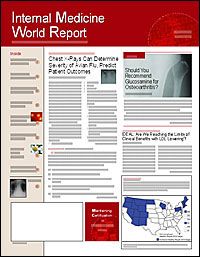Chest X-Rays Can Determine Severity of Avian Flu, Predict Patient Outcomes
From the Radiologic Society of North America
CHICAGO?Certain radiologic features can predict survival in patients infected with the avian influenza virus H5N1, according to Nagmi Qureshi, MD, FRCR, a fellow in thoracic imaging at Churchill Hospital, Oxford, Eng?land. Dr Qureshi presented the results of a recent study of 23 patients admitted to Ho Chi Minh City Hospital, Vietnam, during the Radiologic Society of North Am?erica ?annual meeting.?
The study evaluated patients admitted to the hospital who met the requirements for the Viet?na?mese case definition of avian flu, which includes:
? Temperature >38?C
? Sore throat
? Cough
? Dyspnea
? Possible infectious contact within the 7 days before the onset of symptoms, based on 1 of the following conditions:?
? Contact with an infectious person with a confirmed case of H5N1 infection
? Visit to a poultry farm orother place containing birds in an area with outbreaks
? Contact with birds of certain species that were ill or have died
? Working in a lab processing samples from humans or animals with suspected H5N1 infection.?
Of the 23 patients initially screened, 14 patients (aged 8-35 years) tested positive for H5N1 infection by viral culture. These patients were included in the study. Each participant had an average of 7 chest x-rays performed during his or her hospital stay. Overall, the study included 2 children and 12 young adults. ?
Mortality in this group of patients with documented H5N1 infection exceeded 60%, with a total of 9 patient deaths. In evaluating the differences in chest x-ray findings between the mortality group and the survival group, the investigators looked at both radiographic findings and overall severity of lung consolidation (Figure), as was seen on the patients' x-rays in both groups.
Chest x-rays were divided according to body area zones, and the number of lung zones involved in each individual x-ray was determined. Significant radiographic findings included:
? Multifocal and focal consolidation
? Pleural effusions
? Cavitation
? Lymphadenopathy
? Collapse
? Pneumothorax.
Regression analysis to evaluate how the presence or absence of individual findings could affect the outcome revealed that certain x-ray features were significantly associated with mortality.
Specifically, patients whose chest ?x-rays showed involvement of >=4 lung zones, either at presentation or at day 7, had a higher mortality rate than patients with less consolidation on chest x-ray. These results should indicate to phy?si?cians caring for patients with confirmed or suspected H5N1 virus infection that x-ray findings may help predict mortality. ?
"All the patients that came in with very severe changes on chest x-ray died," stated Dr Qureshi. At the same time, x-ray findings turned out to be one of the few predictors of ?mortality in the study. "The statistical tests we used found no association between age, gender, and outcome," Dr Qureshi added.
The investigators were also able to draw certain conclusions about chest x-rays in patients with avian flu. Almost every patient in the study had multifocal consolidation on chest x-ray, leading to the conclusion that this x-ray feature is an important manifestation of avian flu. Thus, in a patient with suspected but not sero?logically confirmed avian flu, the finding of multifocal consolidation on chest-x-ray could help guide the diagnosis. Along with pneumothorax, multifocal consolidation in patients with documented avian flu was associated with the highest mortality among all x-ray findings. ?
Avian flu, the deadly and feared form of influenza affecting poultry and some humans in Asia, has not become widespread yet. But as concern about the possibility of a large avian flu outbreak mounts, initial research on patients who have contracted this deadly virus can assist clinicians who might care for patients with this disorder in the future. It may also be useful to be on the alert when seeing patients from endemic areas as a ?precautionary measure at this point.
